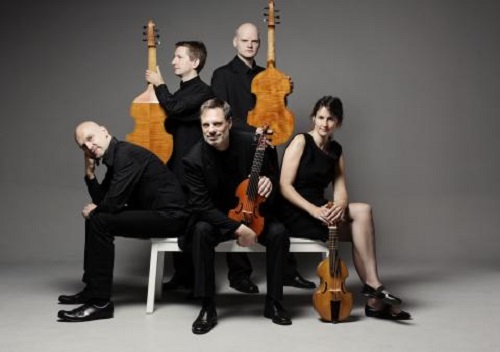 United Kingdom Lawes, Locke: Elizabeth Kenny (theorbo), Phantasm [Laurence Dreyfus (director/treble viol), Emilia Benjamin (treble viol), Jonathan Manson (treble viol), Markku Luolajan-Mikkola (bass viol)], Wigmore Hall, London, 22.5.2017. (CS)
United Kingdom Lawes, Locke: Elizabeth Kenny (theorbo), Phantasm [Laurence Dreyfus (director/treble viol), Emilia Benjamin (treble viol), Jonathan Manson (treble viol), Markku Luolajan-Mikkola (bass viol)], Wigmore Hall, London, 22.5.2017. (CS)

William Lawes – Royal Consort No.10 in B flat, No.5 in D, No.6 in D
Matthew Locke – Consort of 4 Parts No.5 in G minor, The Flat Consort in C minor (‘for my cousin Kemble’).
It is political turmoil rather than musical revolution for which the reign of Charles I is best known, but this illuminating and refreshing lunchtime recital by the members of Phantasm, led by founder and director, Laurence Dreyfus, with lutenist Elizabeth Kenny, confirmed that before the Civil War which rent the nation, Charles’ court must have been a culturally sophisticated and innovative milieu.
A leading figure in royal cultural circles was William Lawes (1602–45), who in 1635 was appointed as a ‘musician in ordinary for the lutes and voices’. Some compositions collected in his Royal Consort – ten suites, organised by key, a Fantasy or Pavanne often being followed by a sequence of short dance movements – probably pre-dated his royal appointment, but the title attests to his political allegiance: his sympathies saw him join the royalist cause and meet a premature death in battle, fighting for his patron.
The three consorts presented here showed Lawes to be adventurous, imaginative and erudite, the independence of the contrapuntal lines resulting in sharp dissonances which paradoxically suggest both artifice and anarchy.
The striking character of Phantasm’s ensemble playing was immediately apparent in the opening Royal Consort No.10 in B flat. There was a surprising brightness and ‘edge’ in the higher lying lines, and sustained vigorous interplay between the voices. Though the blend was beguiling – and at times the clusters of notes were quite compressed – the individual lines were sharply defined, so that we could appreciate the nimble finger-work and delicate ornamentation. As Lawes meandered between moods, the emotional progression – frequent changes of material, tempo, colour created an improvisatory air – was seamlessly articulated. Kenny – having swapped the Arab servant robes she donned for the first performance of Cavalli’s Hipermestra at Glyndebourne two days previously for more sombre black attire – alternated between muscular theorbo interjections and a lighter continuo role in the shorter dances. A short pause – as if the dancers were taking a recuperative deep breath – preceded the sequence of dances: now there was a burst of energy, the intensity relaxed. Markku Luolajan-Mikkola’s bass line was a sure foundation, but also surprisingly light-toned. The final triple-time, homophonic dance brought a conclusive regularity after the asymmetries of the preceding movements.
Consort No.5 in D was notable for its rich opening, with sustained tones asserting confidently against broad, moving lines; as the texture cleared, the middle voice assumed greater prominence, the irregularity of the motifs and phrasing being highlighted. There was a nice bite to the articulation in the warm, relaxed dance that followed, though the slow, quiet ending suggested a reflective ‘taking stock’ as it moved through minor-key realms. A vigorous jig wound itself up – one could almost feel the heat coming off the dancers! – the rapid changes of rhythmic structure scarcely allowing the music to settle, the bass adding to the excitement by occasionally nudging through the texture. Consort No.6, also in D major, which closed the recital featured some striking ornamental flourishes. Kenny’s cadence to the penultimate dance was wonderfully affecting and her brisk strumming invigorated the concluding romp.
Between Lawes’ consorts, two works by Matthew Locke were interwoven. Born a generation after Lawes, it is unlikely that Locke – reported to have been a stern, irascible man – would have found favour amid the urbane elite of Charles I’s court. He was disdainful of foreign music, though he had transcribed a collection of Italian motets early in his life, writing in the Preface to his ‘Little Consort’ of 1656: ‘I never yet saw any Forain Istrumental Composition (a few French Corants excepted) worthy an English mans Transcribing [sic]’.
Locke’s Consort of 4 Parts comprises 24 movements and was probably composed shortly before the Restoration of Charles II in 1660, whereupon Locke gained several royal appointments. (Phantasm released a recording in 2001.) The rich homogeny of Phantasm’s playing at the start of the Fantasy which opens the G minor consort wonderfully emphasised the intensity of the minor mode, twisting briefly to major and then back – a sort of harmonic squirming of discomfort and downheartedness. Chromatic arguments were plaintively posed; then, a more assertive vigour intervened. The final movement was dry and curt – perhaps reflective of Locke’s own temperament; Phantasm rejoiced in the rhythmic displacements and virtuosity.
The three-part ‘Flat Consort’ – so named for its key signature – is in six movements, fantasias alternating with short dances: a courant, sarabande, and jig. I was impressed by the way Phantasm and Kenny built the increasingly burly lines, coming to rest on a strikingly contrasting unison after the preceding restlessness. The dark instrumental colours were vivified by snatched, sprung rhythms that seemed to anticipate the Scotch snaps of Purcellian recitative, and the contrapuntal sequences had a hypnotic pull. Kenny’s theorbo once again came to the fore in the stylised, elaborate concluding episode which faded deliciously to niente.
This performance was polished but also quite liberated. Phantasm and Kenny revelled in the quirky dissonances and rhythmic jauntiness of the idiosyncratic but beautiful music of Lawes and Locke. A fantastic lunchtime treat.
Claire Seymour